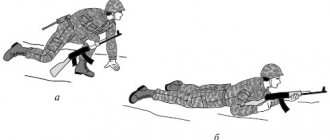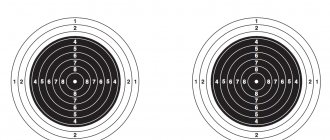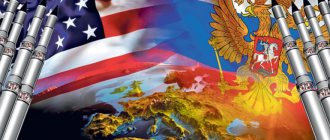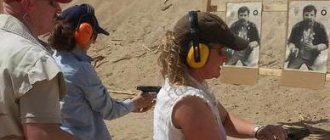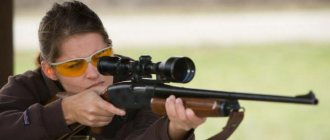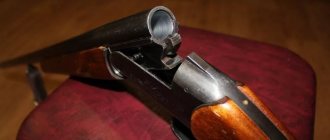FEATURES OF THE ORGANIZATION AND ORDER OF SHOOTING AND SPECIAL TRAINING CLASSES
General organizational and methodological instructions
This Collection defines the features of conducting fire training classes and provides for training in several stages, with intermediate improvement of acquired skills during scheduled fire training classes.
The first stage is designed to instill initial skills in fire training in the trainee and determine the direction for his further improvement in planned classes. During this period, the following are studied: safety requirements; material part of the weapon; basics and rules of shooting; Shooting training is conducted.
The second stage is training in the use of weapons by performing the exercises provided in this collection.
Third stage: performing control shooting exercises.
When performing shooting exercises, trainees must wear field uniforms, personal armor protection, or a mass-substituting model.
To protect eyes and hearing, safety glasses and shooting headphones are used.
Features of the methodology for organizing fire training classes
One of the main forms of training is shooting training (technical training ). This type of training should be the main form of fire training and should account for at least 70% of the total class time. Shooting training is training without ammunition, aimed at developing the skills of automatic actions of the shooter and developing his muscle memory when operating with a weapon. Beginner shooters without successfully practicing questions during technical training are not allowed to take part in tactical shooting.
Shooting training solves the following problems: developing arm strength endurance; muscle memory; practicing coordination of actions when firing and moving; safe and speedy manipulations with weapons.
During shooting training the following training questions are worked out:
on developing the correct grip of the weapon and its stability at the moment of holding; removing weapons and placing them in a firing position; aiming at a target and firing a shot; moving with a weapon and firing a shot while moving; transferring weapons from hand to hand and shooting from an awkward position; replacing and reloading weapons; shooting from behind cover and obstacles; the order of transferring fire along the front and in depth; shooting from a prone position and low, awkward positions.
When conducting a lesson as part of a group, the following goals are achieved: organizing interaction within the group; distribution of goals; fire control of the group; development of the most optimal method of action.
During complex training during control shooting exercises, to build up the situation, targets may have different colors or visible markings. When assigning a task to perform an exercise, a trained military personnel determines which color targets need to be hit.
During a fire training session, the leader of the session uses an additional command:
“Target” – at which the trainee shoots at pre-specified targets. This command is given during the entire exercise to determine the moment the trainees begin shooting.
FEATURES OF PREPARATION OF EXERCISES
When conducting special fire training classes, the training leader prepares the exercises independently, taking into account the specifics of the existing material base, the availability of target equipment and the level of preparedness of the trainees. This makes it possible to test the skills of students in a constantly changing environment, does not cause them to get used to the monotony of exercises and contributes to more successful development of shooting techniques. When composing exercises, the lesson leader must adhere to the following rules:
1. Fire training exercises must be designed, constructed and conducted SAFELY.
2. The quality level of a fire training exercise is determined by the complexity of the shooting tests presented in the exercises. Exercises should be designed so as not to overestimate the requirements for the student and give him the opportunity to show all the skills he has acquired.
3. Shooting missions should be varied. It is not necessary to create completely new exercises for each lesson. But not a single exercise should be repeated often, so as not to become a criterion for shooting skill in fire training.
4. It is allowed to deviate from the shooting conditions. Therefore, you can determine the conditions for performing the exercise, as well as set a fixed number of shots.
5. Control exercises may include mandatory reloads and may determine stance or shooting position.
Topic 1. Shooting training and shooting
LEGAL TRAININGFEDERAL LAW
July 2016 N 226-FZ
Chapter 1. GENERAL PROVISIONS
Article 10. Detention
1. Military personnel (employees) of the National Guard troops have the right to detain until they are transferred to the police:
1) persons suspected of committing a crime, as well as persons against whom a preventive measure in the form of detention has been chosen;
2) persons who escaped from custody, as well as persons evading serving a criminal sentence.
3) persons evading the execution of administrative punishment in the form of administrative arrest;
4) persons on the wanted list;
5) persons in respect of whom proceedings are being conducted in cases of administrative offenses, classified by the legislation on administrative offenses under the jurisdiction of the National Guard troops - on the grounds, in the manner and for the period that are provided for by the legislation on administrative offenses;
6) persons who violated curfew rules;
7) persons who illegally entered or attempted to enter the territory of objects protected by the National Guard troops.
2. A person subject to detention (hereinafter referred to as the detained person), accompanied by military personnel (employees) of the National Guard troops and subject to conditions that exclude a threat to their life and health, is subject to delivery to the nearest internal affairs agency as soon as possible, but no later than three hours from the moment of arrest.
3. In each case of detention, a serviceman (employee) of the National Guard troops is obliged to explain to the detained person the grounds for detention.
4. The period of detention is calculated from the moment of actual restriction of the freedom of movement of the detained person.
5. Detained persons, the things and documents they have with them, as well as their vehicles, are subject to inspection in the manner established by the legislation on administrative offenses, unless a different procedure is established by federal law.
6. About each case of detention of a minor by military personnel (employees) of the National Guard troops, his parents or other legal representatives are immediately notified.
7. The diplomatic mission or consular office of the relevant foreign state is immediately notified of the detention of a foreign citizen or national of a foreign state by military personnel (employees) of the National Guard troops in accordance with the legislation of the Russian Federation.
8. The command of the military unit in which this serviceman is serving is immediately notified of the detention of a serviceman by military personnel (employees) of the National Guard troops.
9. Military personnel (employees) of the National Guard troops take, if necessary, measures to provide first aid to the detained person, as well as measures to eliminate the threat to the life and health of citizens or property that arises during the detention.
SERVICE TRAINING
27. During the period of service, the senior officer of the SPVO squad provides:
27.1 Organization of service for employees on duty.
27.2 Monitoring the performance of service by employees and providing them with practical assistance in performing assigned tasks.
27.3 Checking the correctness of maintaining official documentation, taking measures to eliminate identified deficiencies.
27.4 Monitoring the safety, serviceability, and correct use of communication equipment and other technical and special equipment issued along with them.
27.5 Report to the senior duty officer (on duty) of the central control center (GOSDN, PTS) or a person authorized by the head of the educational institution or branch about his location and situation at the guarded facility, the patrol route (traffic) at least once an hour.
28. Actions of a SPVO employee while on duty:
28.1 Upon arrival at the POO, patrol (traffic) route, in the NML from the employee being replaced, information about the incidents that took place, the safety and integrity of property, and road conditions on the patrol (traffic) route.
28.2 When entering the POO, the patrol route (traffic), in the NML, check the serviceability of technical equipment, service vehicles, communication equipment, other technical means, signaling devices and warning signs, conduct a visual assessment of the engineering and technical condition of the protected object, fire extinguishing and water supply equipment, carry out a walk-through protected object (territory) and check the serviceability of doors, windows, gates and locking devices on them, overpasses for inspection of vehicles, observation towers, turnstiles, and if impossible, the compliance of seals and seals with their impressions (casts) and documentation in accordance with the list of official documentation kept by the detachment of the private security combat unit (Appendix No. 4 to this Manual).
28.3 Report to the senior duty officer (duty officer) of the central control center (GOSDN, PTS) about accepting the post, entering the patrol route (movement), in the NML and about the identified shortcomings, and when joining the VET and in the NML, also make an appropriate entry in the Post Acceptance Book and inspections of service (Appendix No. 5 to this Manual).
28.4 Report once an hour to the senior officer of the squad or the senior officer on duty (duty officer) of the central control center (GOSDN, PTS) or a person authorized by the head of the military unit or branch about the situation at the guarded facility, the patrol route (movement) with a time stamp of the report in the Book of check-in and check-out of the post and inspections duty, the logbook of the detention group 1 (patrol) (Appendix No. 6 to this Manual), the logbook of the squad for protecting property during transportation (Appendix No. 7 to this Manual). If signs of a violation of the integrity of the protected object, an offense, or emergency circumstances are detected at a guarded facility or patrol (traffic) route, report immediately. In the event of an NT leaving a constituent entity of the Russian Federation, report to the senior duty officer (duty officer) of the TsOU (GOSDN, PTS) about the situation along the route at all stopping (rest) places.
28.5 Arm (disarm) if the protected facility has autonomous means of security, fire and alarm systems, premises connected to a small-capacity concentrator (if these functions are provided for by the procedures of the SPVO units), keep a log of checks on the status of security, fire and security systems and alarm systems and registration of their activation at the post (Appendix No. 8 to this Manual), as well as check the operability of security, fire and alarm systems.
29. When accepting (surrendering) a post, patrol route (traffic) and NMP, it is prohibited to transfer weapons, ammunition and ammunition between employees without handing them over to the storage place.
30. When serving at posts and patrol (traffic) routes, employees are prohibited from:
30.1 Draw a weapon if there is no reason to use it; unnecessarily send a cartridge into the chamber; transfer weapons, ammunition and ammunition to unauthorized persons; leave weapons and ammunition for them; disassemble (assemble) weapons and clean (lubricate) them.
30.2 Sleep, eat, drink (during times not intended for sleeping and eating), read, use personal communications, smoke, perform natural needs or otherwise be distracted from the performance of one’s duties, triggering the TSO by one’s actions.
30.3 Use computer equipment, television, video and radio receivers, other equipment with the function of viewing video and television programs that is not intended for use while on duty, as well as equipment that contributes to distraction from the performance of one’s duties in the POO, in the NMP, and in service vehicles. responsibilities.
30.4 Violate the rules of radio communication, conduct communications via communications that are not related to the performance of duties.
30.5 Entrust the protection of property and (or) objects to other persons.
30.6 Enter residential buildings, places of trade, entertainment centers and other premises without official need.
30.7 Leave the protected object from which the alarm signal was received without the permission of the senior duty officer (duty officer) of the central control center (GOSDN, PTS), until its cause is fully clarified.
30.8 Independently lock or open doors, windows, shutters, install or remove locks, apply (remove) seals, seals, move property, turn on or off TSO, if this is not provided for in the procedure of the SPEYU squads.
30.9 Protect property and (or) objects not specified in the SPVO squad card.
30.10 Use official vehicles for purposes other than their intended purpose.
30.11 Deviate from the requirements of the Traffic Rules of the Russian Federation, except in cases of performing an urgent official task, subject to ensuring road safety, as well as deviate from the patrol (traffic) route, violate the order of duty.
30.12 Transfer control of a service vehicle to persons who do not have the right to do so.
30.13 Leave detainees unattended in a service vehicle, transport a detainee alone in the back seat of a car, as well as two or more detainees in one vehicle that is not equipped with a compartment for detainees.
30.14 Disable or change the configuration of the settings of radio communications, positioning systems and video recording of events installed on a service vehicle, otherwise interfere with the operation of these means and systems, as well as copy video files and transfer them to third parties.
I V. Organization of preparation for service and briefing
TOPOGRAPHIC PREPARATION"
WAYS TO DETERMINE THE SIDES OF THE HORIZONT
Before noon, you need to divide the angle on the dial that the hour hand must pass before 13 o'clock. In Russia, the clock hand is moved 1 hour forward, therefore, we will have noon at 13 o’clock rather than 12 o’clock, and the afternoon will be the one that it passed after 13 o’clock.
ADDITIONAL CLASSES
_________________________________________________________________________________________________________________________________________________________________________________________________________________________________________________________________________________________________________________________________________________________________________________________________________________________________________________________________________________________________________________________________________________________________________________________________________________________________________________________________________________________________________________
1Next ⇒
